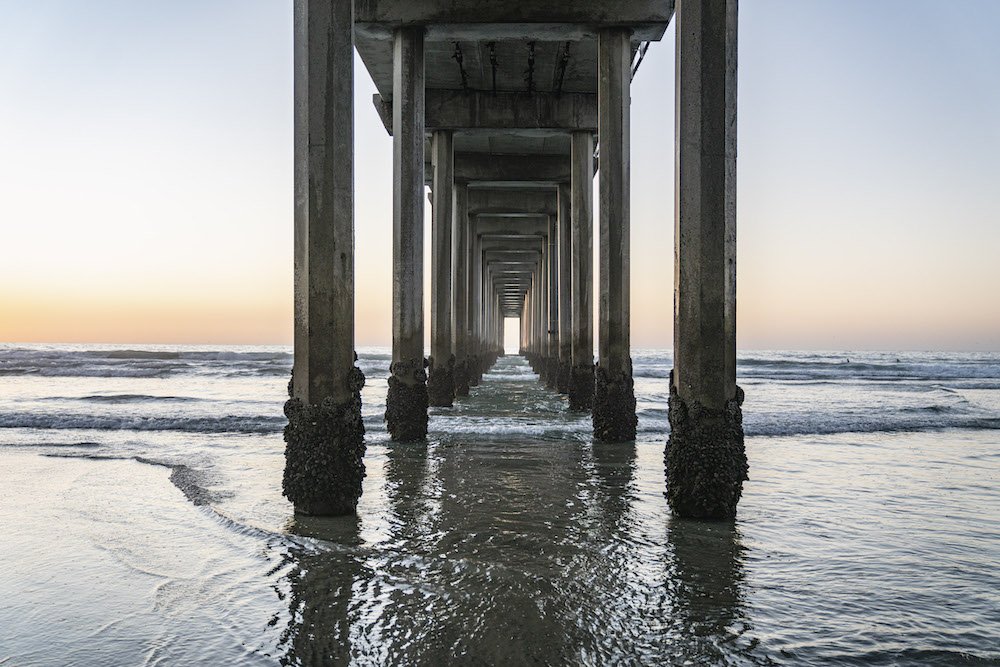How To Avoid The Crowds In Lake Tahoe
Lake Tahoe beckons adventure seekers year-round with its breathtaking landscapes and a plethora of outdoor activities. Whether you find yourself on the North or South shores, this iconic destination is a haven for those craving adrenaline-fueled escapades and serene moments in nature. Yet, amid its undeniable allure, Lake Tahoe grapples with a pressing challenge – overcrowding. The surge of visitors during peak seasons transforms this paradise into a bustling hub, prompting the need for savvy strategies to navigate the crowds and unearth the region's hidden treasures.
Emerald Bay is one of the most crowded spots in all of Lake Tahoe. Photo by Dalton Johnson
Where the Tourism Issue Comes From
Lake Tahoe faces a tourism issue primarily due to its stunning natural beauty and diverse recreational opportunities, which attract millions of visitors each year. The lake's crystal-clear waters, surrounded by picturesque mountains and forests, make it a magnet for outdoor enthusiasts, from hikers and skiers to water sports enthusiasts. This popularity leads to crowded conditions, especially during peak seasons like summer and winter, when tourists flock to the area for activities such as boating, skiing, hiking, and rock climbing.
Additionally, the region's limited infrastructure and delicate ecosystem exacerbate the tourism issue. Lake Tahoe's roads, parking facilities, and public amenities can become overwhelmed during peak times, causing traffic congestion and strain on resources. Furthermore, the influx of visitors puts pressure on the lake's environment, leading to concerns about pollution, habitat degradation, and erosion. Addressing these tourism challenges requires a balanced approach that promotes sustainable tourism practices, conservation efforts, and responsible visitor behavior to preserve Lake Tahoe's natural beauty for future generations.
High and Low Seasons
Summer (High Season)
From late June to early September, Lake Tahoe experiences its high season, attracting a significant influx of visitors. This period coincides with warm weather, making it ideal for outdoor activities like hiking, biking, water sports, and beach outings. The shores of Lake Tahoe come alive with bustling beaches, waterfront activities, and lively towns.
Activities: Visitors can indulge in a wide range of activities such as swimming, kayaking and paddleboarding, jet skiing, and beach volleyball. Hiking trails, including those in the Desolation Wilderness and Emerald Bay State Park, offer breathtaking views and opportunities to explore the natural beauty of the region.
Events: The summer season also hosts various events and festivals, such as the Lake Tahoe Shakespeare Festival, music concerts, art shows, and food and wine tastings. These events add to the vibrant atmosphere of the area, attracting tourists and locals alike.
Accommodations: Due to the high demand, accommodations such as hotels, resorts, cabins, and vacation rentals can book up quickly during this peak season. It's advisable to make reservations well in advance to secure preferred accommodations.
Winter (High Season)
Winter, particularly from December to February, is another high season for Lake Tahoe, drawing crowds of winter sports enthusiasts. The region transforms into a winter wonderland, offering world-class skiing, snowboarding, snowshoeing, and other snow-centric activities.
Ski Resorts: Lake Tahoe is home to renowned ski resorts such as Heavenly, Northstar, Kirkwood, and Squaw Valley. These resorts offer diverse terrain, modern amenities, and a range of accommodations, attracting skiers and snowboarders of all levels.
Activities: Apart from skiing and snowboarding, visitors can enjoy activities like snowmobiling, ice skating, sledding, and snow tubing. Scenic gondola rides provide panoramic views of the snow-covered landscape, adding to the winter experience.
Events: Winter in Lake Tahoe also hosts events like snow sports competitions, holiday celebrations, snow sculpture contests, and après-ski parties. These events contribute to the festive ambiance of the area, making it a popular destination for winter vacations.
Accommodations: Similar to summer, accommodations during winter can fill up quickly, especially around major holidays and peak weekends. Planning ahead and booking accommodations in advance is advisable to ensure a smooth and enjoyable winter getaway.
Understanding the high and low seasons in Lake Tahoe helps travelers plan their trips effectively, whether they seek a bustling summer adventure or a winter escape filled with snow sports and festivities.
Crowds by Activity
Summer Crowded Spots:
Beaches: Sand Harbor State Park and Kings Beach State Recreation Area are magnets for beachgoers. Consider visiting early morning or late afternoon for a quieter experience.
Hiking Trails: Popular trails like Eagle Lake and Mount Tallac can get crowded. Opt for lesser-known trails such as Rubicon Trail or Shirley Canyon for tranquility.
Water Sports: Avoid peak times for paddleboarding, kayaking, and jet skiing. Try quieter spots like Fallen Leaf Lake or Donner Lake for a serene water adventure.
Winter Crowded Spots:
Ski Resorts: Heavenly and Squaw Valley attract large crowds. Consider smaller resorts like Homewood or Diamond Peak for a more relaxed skiing experience.
Snowshoeing and Cross-Country Skiing: Explore less-visited areas like Hope Valley or Spooner Lake for peaceful winter hikes and cross-country skiing.
Towns and Restaurants: Popular towns like Truckee and South Lake Tahoe can be bustling. Try exploring nearby towns like Tahoe City or Incline Village for a quieter dining experience.
How You Can Help with the Issue
As a visitor to Lake Tahoe, there are several ways you can contribute positively to address the tourism issue and minimize its impact on the environment and local communities:
Practice Sustainable Tourism: Follow Leave No Trace principles by packing out your trash, staying on designated trails, and respecting wildlife and natural habitats. Minimize your carbon footprint by using public transportation, carpooling, or opting for eco-friendly transportation options.
Support Local Businesses: Choose to dine at locally-owned restaurants, shop at small businesses, and stay in accommodations that prioritize sustainability and responsible tourism practices. By supporting local businesses, you contribute to the economic well-being of the community and promote a more authentic travel experience.
Volunteer for Conservation Projects: Consider participating in volunteer programs or conservation initiatives focused on preserving Lake Tahoe's environment. Join beach clean-ups, trail maintenance efforts, or educational programs that promote environmental stewardship and conservation awareness.
Educate Yourself and Others: Learn about the challenges facing Lake Tahoe, such as pollution, habitat loss, and overcrowding, and share this knowledge with fellow travelers. Encourage responsible behavior among your peers, such as avoiding sensitive areas, following regulations for watercraft and recreational activities, and respecting wildlife and local cultures.
Support Sustainable Tourism Initiatives: Advocate for sustainable tourism policies and initiatives that promote responsible travel practices, conservation efforts, and community engagement. Stay informed about local environmental issues and support organizations working towards preserving Lake Tahoe's natural beauty and cultural heritage.
Here Are Five Ways To Avoid The Crowds In Lake Tahoe:
To truly experience the serene beauty of Lake Tahoe without being engulfed by crowds, strategic planning and a sense of adventure are your allies. Here are some tried-and-true strategies to help you navigate this popular destination while finding moments of solitude and tranquility:
Choose Off-Peak Times: Timing is everything. Plan your visit during shoulder seasons like late spring or early fall when the crowds thin out, allowing you to immerse yourself in the region's natural wonders without the hustle and bustle of peak tourist seasons.
Explore Lesser-Known Trails: While popular trails offer stunning vistas, they can also attract hoards of visitors. Venture off the beaten path to discover hidden gems like Winnemucca Lake Trail or secluded sections of the Tahoe Rim Trail. These less-traveled routes offer a chance to connect with nature in peace, away from the crowds.
Embrace Early Mornings or Late Evenings: Lake Tahoe reveals its most enchanting side during sunrise and sunset. Plan outdoor activities such as kayaking, paddleboarding, or hiking during these magical hours to enjoy the beauty of the lake with fewer people around.
Discover Secret Beaches: While Sand Harbor and Kings Beach draw crowds, Lake Tahoe is dotted with hidden coves and beaches waiting to be explored. Take a short hike to spots like Chimney Beach or Skunk Harbor, where you can relax by the water in serenity, far from the crowds.
Visit Midweek: Weekends often see an influx of travelers, especially during summer and winter. If your schedule allows, plan your visit for midweek days. This simple shift can make a significant difference, offering you a more relaxed and uncrowded experience throughout the region.
Getting ice cream at Camp Richardson in South Lake Tahoe. Photo by Dalton Johnson
Lake Tahoe's allure as a premier destination for outdoor enthusiasts comes with the responsibility of addressing its tourism challenges effectively. By understanding the high and low seasons, choosing less crowded activities and locations, and practicing sustainable tourism behaviors, visitors can enjoy Lake Tahoe while minimizing negative impacts on the environment and local communities.
It's crucial to support local businesses, participate in conservation efforts, and educate oneself and others about responsible travel practices. By working together to preserve Lake Tahoe's natural beauty and cultural heritage, we can ensure that this iconic destination remains a vibrant and sustainable paradise for generations to come. So, let's embrace the spirit of responsible tourism and make a positive difference in preserving the magic of Lake Tahoe for all to enjoy.









